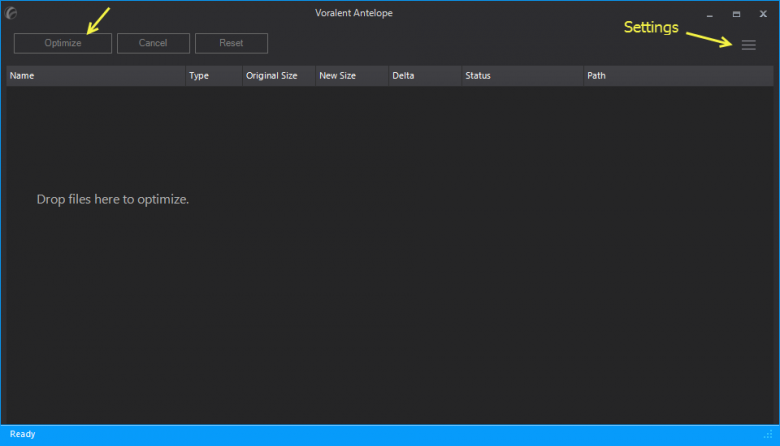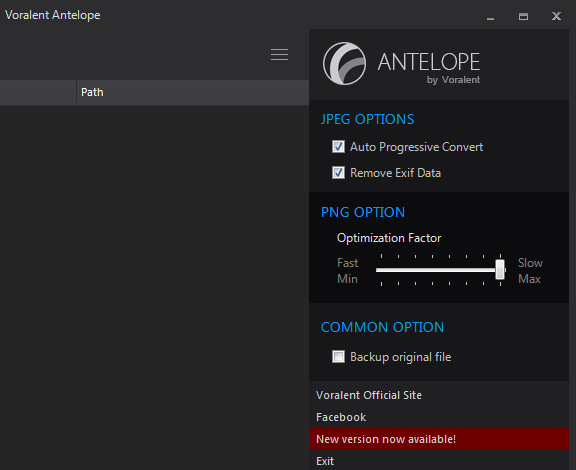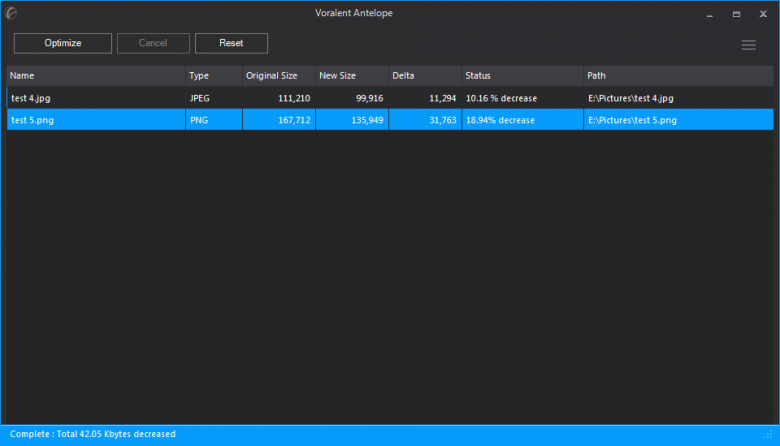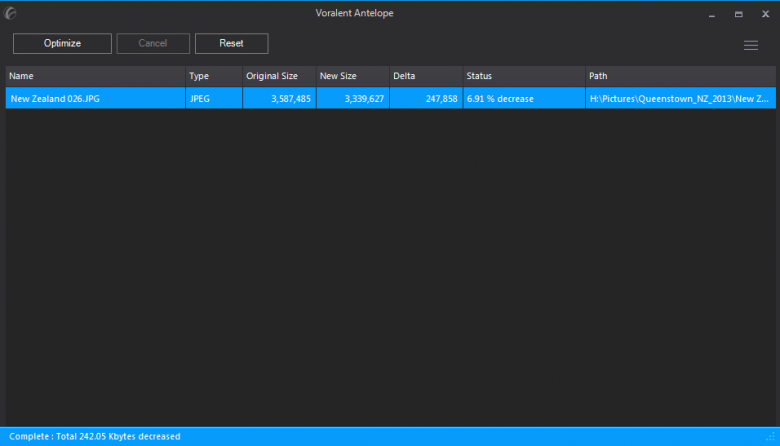Most writers tend to work with screenshots and images regularly, and I am certainly no exception. My duties here at DCT involve working with images pretty much on a daily basis, and as image file sizes can have a seriously negative impact on page loading times it’s important to keep them to a minimum while at the same time retaining reasonable levels of quality. Consequently, I tend to get a tad excited whenever I come across a freeware which is specifically designed to reduce image file sizes without any substantial loss of quality.
Despite it’s rather strange and obscure name, that’s exactly what Voralent Antelope promises to do:
Voralent Antelope is a simple free software which rewrites JPEG and PNG files to reduce their size, without losing any image quality.
Voralent Antelope – Download and Usage
Download is a 2.2MB zip folder which, according to Virus Total, is 100% clean. To install Voralent Antelope, extract the contents of the downloaded folder and run the extracted executable (Antelope.Setup.exe).
Using Voralent Antelope is simplicity personified, just drag and drop the images into the main interface and then click on the Optimize button:
 Settings are also simplistic, with very few options to choose from:
Settings are also simplistic, with very few options to choose from:
I wanted to make sure the program was achieving maximum reduction possible so I enabled the option to “Remove Exif Data” from JPEGs and moved the PNG optimization slider over to Maximum beforehand. Note also the option to backup original files, if this is left disabled, the original files will be overwritten by the new (optimized) files.
I first tested Voralent Antelope using two screenshot images with smallish file sizes, one for each format and just the kind of images I might be looking to insert into an article:
As you can see from the above screenshot, Voralent Antelope reduced the original JPEG file size from 108KB down to 97.6KB (10.16%) and the original PNG file size from 163KB to 132KB (18.94%). This is not a significant decrease by any means but in the software’s defense there was also no discernible loss of quality.
Next, I tested the software’s ability with much larger file sizes using a high quality digital photo:
Voralent Antelope reduced the original JPEG file size from 3.42MB down to 3.18MB (6.91%), definitely not a significant decrease.
Voralent Antelope – Bottom Line
It appears Voralent Antelope’s optimization is more attuned to retaining quality rather than any significant reduction in file sizes. I understand that it must be difficult to achieve a balance which suits every users’ needs, but for me, I’d prefer the ratio to be reversed – I’m quite prepared to sacrifice a little quality in favor of more greatly reduced file sizes.
Voralent Antelope has a lot going for it, including; straightforward bundle free installation, a simple user friendly interface, and high quality results, but in the end, it just doesn’t reduce file sizes anywhere near enough to warrant high praise or be particularly useful for me.
- If you think Voralent Antelope might suit your requirements, you can check it out and download direct from the developer here: http://www.voralent.com/products/antelope/
Best Free Methods for Reducing JPG & PNG Image File Sizes?
Over the years I’ve checked out many of these types of programs that promise to reduce file sizes for JPEG and PNG images, very few live up to their claims, some simply do not work at all, especially with PNG images.
I’ve found that the best possible [free] method for achieving a significant and user-defined reduction in JPEG images is via FastStone Image Viewer, you can view a how-to guide here: Resize photos using FastStone Image Viewer – Part 2
I’ve yet to come across a freeware which has any significant impact on reducing PNG file sizes but I did happen upon a site which offers this service for free: https://tinypng.com/. I’ve been using TinyPNG for some time now and it is very easy to use and does significantly reduce PNG image file sizes (up to 60 – 80%) while retaining perfectly acceptable quality. Highly recommended.
Postscript – WebP
Google’s ‘WebP’ image format may soon make this type of discussion immaterial anyway. The new format is said to achieve excellent lossless image compression. A number of popular applications have already adopted support for WebP, including Google Chrome (naturally) and several free image viewers. Others are in the pipeline, notably Firefox. Read more on Wikipedia here: WebP
Voralent, the developer of Antelope, has also released a dedicated software to convert images to the WebP format, called ‘WebPconv ‘ and available for download here: http://www.voralent.com/download/






Hey Jim,
Maybe I’ve just missed something in this article, but I’ve been using FastStone “Photo Resizer” for several years now and it is very fast and very versatile. http://www.faststone.org/FSResizerDetail.htm
Keep Smilin’…
Gus
For pure convenience when downsizing jpegs for email or the web I find Robosizer a great program. http://www.robosizer.com/ You set it up to decrease a certain percentage or to a selectable image size. Once it is configured, everytime you upload an image via your browser or attach one to your email, the photo is automatically resized. If you upload a lot of photos, this program is super convenient. It is free although you have to supply a username and password(available on website) when you set the program up.
I have been using the free version of VSO Image Resizer for several years. I only have experience of its use with JPEG’s but it achieves significant reduction without a huge quality compromise. You can choose the post process x y pixel count. I use it to reduce the size of photos before emailing them, something that more people need to do considering the size of photos these days. Since most people receiving the files will view the images on a monitor the appearance is more than acceptable.